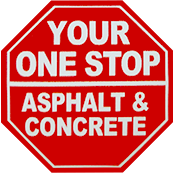In the world of asphalt paving materials, there are two types: hot mix and cold mix.
Hot mix combines materials like sand, stone and fuel oil with water then heats them to the optimum temperature (between 160 and 190 degrees Fahrenheit). The mixture is then placed in a mixing truck, batch plant or pug mill.
Cold mix asphalt is made by reducing the temperature of asphalt mixes. It can also be made by mixing water and liquefied natural gas (LNG). The most common cold mix asphalt is Portland cement concrete mixed with coarse aggregate and then “cold-mixed” with hot-mix emulsion to make a pavement surface that can be driven on within minutes.
Uses for cold mix asphalt
Cold mix asphalt is most commonly used when repairing small cracks and potholes. It can be used of larger patching projects when the outside temperature is too cold for proper hot mix asphalt installation. Because cold mix is not as strong as hot mix, it should be used as a temporary fix for smaller projects that can get your property through a season or two before you are able to permanently repair or replace the surface.
Uses for hot mix asphalt
There are hundreds of uses for hot mix asphalt, and it’s best to use for large-scale paving applications. The most popular use of hot-mix asphalt is in road construction because it has good drainage qualities and lower permeability than other paving materials. The benefits of using hot mix asphalt include reduced shrinkage cracks due to low permeability of the hot mix and improved durability due to the high compressive strength of hot-mix asphalt pavements.
How to maintain hot mix and cold mix asphalts
Asphalt maintenance refers to replacing components in asphalted surfaces to maintain or improve their performance. Overlay materials are often used in hot mix asphalt for various purposes, such as providing a base layer, suppressing cracking and providing colorant for decorative purposes.
Some maintenance techniques include:
- Asphalt milling
- Surface sealing with bituminous mixtures and mineral oils
- Fine-grinding to remove excess aggregate
- Patching with hot mix or cold mix
The lifespan of hot mix asphalt is approximately 20 years, while cold mix asphalt has a lifespan of approximately 12 years. The higher the volume of traffic on hot mix asphalt, the shorter its lifespan. The lifespan of a hot mix is reduced as soon as it becomes saturated with oil and water.
Maintaining an asphalt commercial driveway or parking lot can be difficult because, unlike concrete or stone, it doesn’t have a natural life cycle. Asphalt also reacts with air pollutants from cars and trucks, which can result in faded colors and cracking surfaces.
It takes six to eight hours for cold mix asphalt to harden after being applied, so you need to plan ahead when doing your construction project.
How A1 Asphalt can help with your project
At A1 Professional Asphalt & Sealing, LLC, we know the ins and outs of each asphalt mix and help you choose the best one to meet your needs. We proudly serve the Midwest Region, helping with all of your commercial asphalt necessities.
To learn more about the other commercial asphalt and concrete services we offer in the St. Louis area, contact us for a quote today to get the job done quickly and efficiently!

